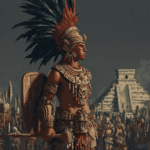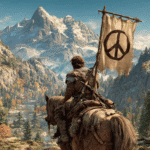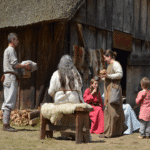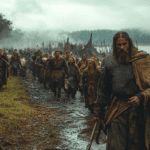
Sprawling across the mesas and canyons of what is now the Four Corners region of the American Southwest, the Ancestral Puebloans – often called the Anasazi – stood at the heart of a vibrant civilization that would leave behind enigmatic cliff dwellings, elaborate kivas, and a legacy that still resonates through the pueblos of today. Their story is a tale of flourishing communities, technological and artistic achievements, and, by its tumultuous end, environmental stress, conflict, and warfare as old traditions faded and new uncertainties took hold.
The Classic Pueblo Period
The Classic Pueblo Period, often referred to as Pueblo II (c. AD 900–1150) and Pueblo III (c. AD 1150–1300), witnessed the blossoming of Anasazi culture. From their humble beginnings in the Basketmaker periods, the Ancestral Puebloans evolved into settled agriculturalists, constructing communities of interconnected rooms, kivas (ceremonial chambers), and, by the later centuries, defensively placed cliff dwellings that would become icons of their civilization.
Between AD 900 and 1150 – the “Golden Age” – rainfall was steady, crops flourished, and populations grew tenfold. Three enormous centers – Mesa Verde, Chaco Canyon, and Taos Pueblo – emerged, their stone masonry and aesthetic brilliance attesting to a people skilled in architecture, ceramics, and communal organization. Trade networks reached across hundreds of miles, bringing turquoise, macaws, corn, and pottery from distant corners of the Southwest and Mesoamerica.
Art, Agriculture, and Architecture
During those centuries, the Anasazi revolutionized agriculture with new irrigation systems, sophisticated pottery, and food storage techniques. Turkeys were domesticated, and diets diversified with the introduction of beans, which joined corn and squash as staple crops. Large plazas and ceremonial great kivas attested to ritual life’s importance, while fine black-on-white pottery reflected an aesthetic sensibility that rivaled that of contemporary cultures.

Their villages transitioned from clusters of scattered single-family homes to vast, multi-roomed complexes. In Chaco Canyon, a city-like community grew, integrating roads and outlying settlements across a “Chaco sphere” that spanned nearly 60,000 square miles. Monumental “Great Houses” with hundreds of rooms rose from the landscape, their builders using astronomical alignments to plan their architecture.
Threats and Tensions: The Shadow of Conflict
Yet beneath this golden age, tensions simmered. As population densities increased, competition for farmland and resources, especially water, intensified. Relations with neighboring nomadic peoples, such as the Ute, Paiute, and later Apache and Navajo, were often hostile. The term “Anasazi” itself, meaning “ancestors of the enemy” in Navajo, speaks to the fraught relationships that shaped the region’s history.
Archaeological evidence suggests that warfare and violence were not unknown among the Anasazi. During the earlier Pueblo I period (c. AD 700–950), localized raiding, hand-to-hand combat, and skirmishes were common, punctuated by the construction of towers and defensive walls. By Pueblo II, the violence appeared to diminish, replaced with what some scholars interpret as ritualized executions and intimidation to enforce a newly stratified social order.
The Pueblo III Period: Defensive Living and Social Upheaval
But by 1150 CE, the Chaco system collapsed, and new centers like Mesa Verde took prominence. The people began aggregating in larger and more defensible villages. Cliff dwellings were constructed high above the valley floors, accessible only by precarious rock trails – a clear sign of increasing insecurity. The Anasazi abandoned open valley sites in favor of remote canyon alcoves, trading water access for security from potential attackers.
This archaeological shift coincided with mounting evidence of conflict: signs of burned villages, massacres, and, in some cases, body mutilation and cannibalism. Sites like Castle Rock and Cowboy Wash in Colorado reveal dramatic episodes: entire communities were violently destroyed and abandoned, the bodies of men, women, and children left mutilated and, according to some interpretations of cut and burned bones, possibly consumed.
While interpretations differ, these events likely reflect a combination of stresses: raid warfare, social breakdown, starvation, and possibly religious or ethnic strife as populations diverged into hostile factions. The “fear that seemed built into the cliff dwellings” is evoked in scholars’ accounts and in the oral traditions of Pueblo descendants.
The Wars They Fought: Archaeological Evidence and Debate
Were the Anasazi embroiled in organized wars? Not in the sense of standing armies, but large-scale violence certainly occurred. Instead of armies, social groups fought episodic, brutal battles: village raids, massacres, retaliatory attacks, and organized campaigns to expel or eliminate rival factions. Competition for increasingly scarce resources under environmental duress (as the region grew drier after 1200 CE) likely exacerbated conflict.

Notable events include:
- Sacred Ridge Site (near Durango, CO): Excavations revealed mass graves with evidence of disarticulation and violence, interpreted by some anthropologists as an episode of “ethnic cleansing”.
- Castle Rock and Cowboy Wash (southwestern CO): Villages destroyed, their inhabitants violently killed, with signs of postmortem processing considered by many scholars as cannibalism – a deeply controversial interpretation, but supported by coprolite (fossilized feces) evidence.
- Cliff Dwellings of Mesa Verde and Kayenta: Defensive positioning indicates active threat; pottery and ritual objects suggest attempts at alliance-building and social cohesion amid growing external dangers.
Some scholars propose that ritual violence and executions replaced direct warfare in the later centuries, serving to intimidate or control population groups. Others see an influx of outsiders, perhaps Athabaskan-speaking peoples (early Apache and Navajo), as another catalyst for violence and migration.
Collapse and Migration: The End of an Era
By the late 1200s, environmental catastrophes – extended droughts, deforestation, soil exhaustion – combined with fierce internal strife and external threats. Puebloan oral histories speak of mass migration, fleeing enemies and searching for places where “rain and fertility” could be assured. Archaeological traces show sudden abandonment across the Four Corners. The last strongholds, such as Betatakin and Keet Seel, date close to 1286. Just before 1300, the region’s ancient villages were left empty, their people dispersing south and east toward the Rio Grande and Hopi mesas.
Reflecting on those final turbulent years, archaeologist Stephen Lekson wrote, “War is a dismal study”. The retreat from the canyons and mesas, the elaborate rituals, the fortifications, and the persistent beauty of their art and architecture – all testify to a civilization struggling against forces both within and without.

Legacy: Survival and Renewal
Despite the violence and turmoil of their Classic Period, the Anasazi’s descendants endure. Pueblo peoples across the Southwest – the Hopi, Zuni, Acoma, and others – carry forward traditions of art, architecture, and spirituality rooted in those ancient communities. Their dances, prayers, and languages echo the timeless rhythms of a civilization that, with beauty and tragedy, fashioned one of North America’s great chapters.




